Ampelny
This group of petunias combines varieties and hybrids, the stems of which are flexible and long - from 50 to 170 cm. Shoots grow very quickly. Ampel petunias are characterized by increased resistance to adverse conditions, as well as long and abundant flowering. A strong wind can easily damage thin stems, so you need to select a landing site that is as protected as possible from the vagaries of the weather.
Shock wave variety deep purple is distinguished by early flowering and fast growth. The diameter of the flowers reaches 6 cm. This petunia can not only be planted in flowerpots, but also used as a ground cover.
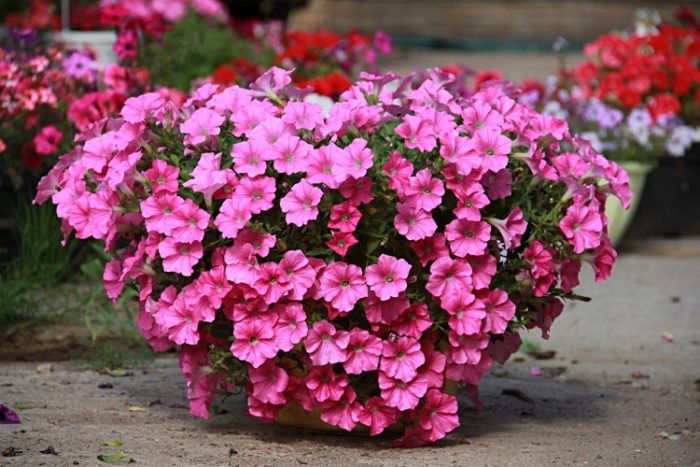
Tumbelina priscilla originated in Japan. It belongs to the terry variety, reproduces vegetatively.
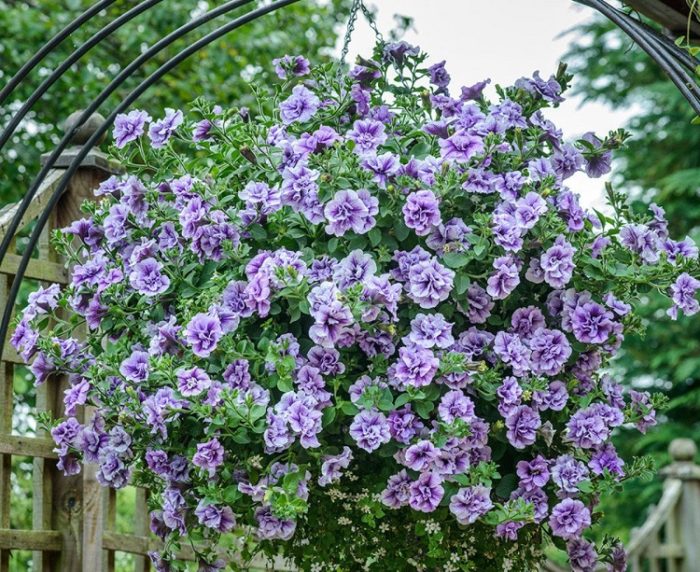
The Picobella cascade F1 variety is hybrid, very resistant to diseases and temperature extremes. It blooms profusely and for a long time.
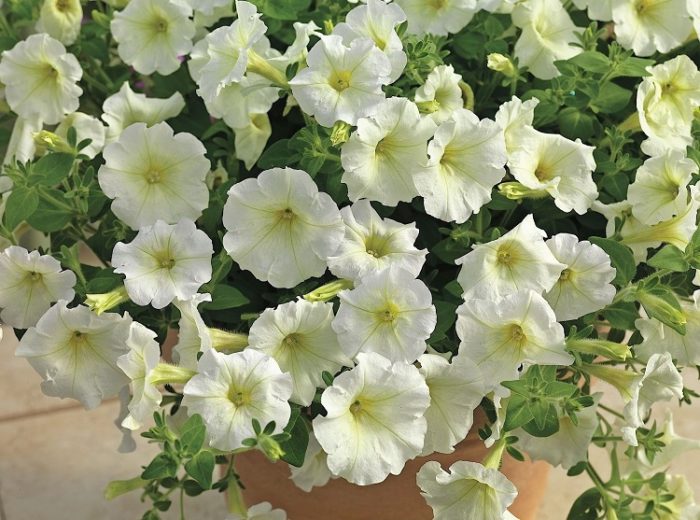
The Raspberry ice variety has a shoot length of up to 1 meter. Flowers - 6 cm in diameter.
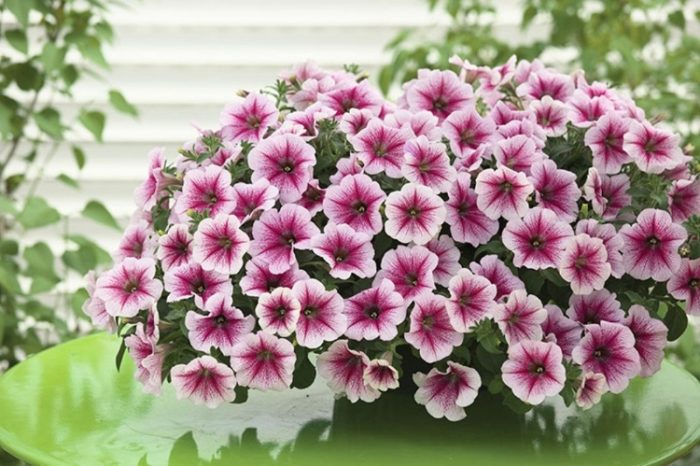
Shoots of Purple petunias grow up to 110 cm in length, flowers - up to 5 cm in diameter.

Pink morn is a bicolor variety with buds up to 6 cm in diameter. Bald spots do not form on the bush.
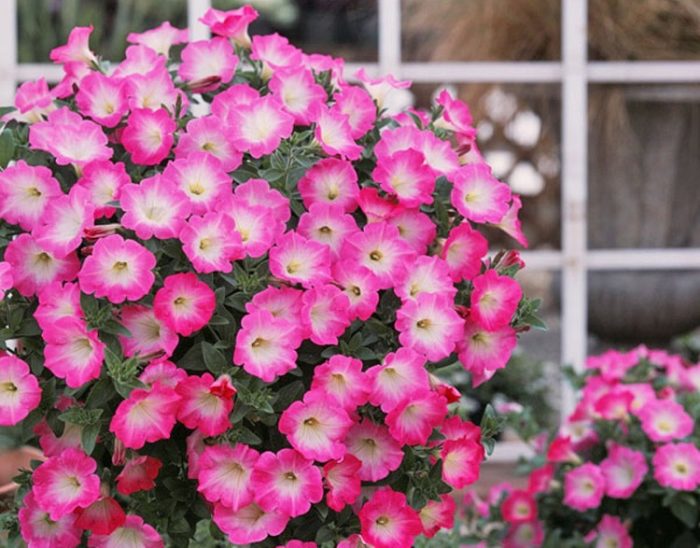
Lilac ice blooms very abundantly from April to July.

Diamond parple F1 variety is distinguished by large bright flowers - up to 9 cm in diameter.

Baby Duck Yellow can be used as a ground cover. The length of the shoots is up to 120 cm.
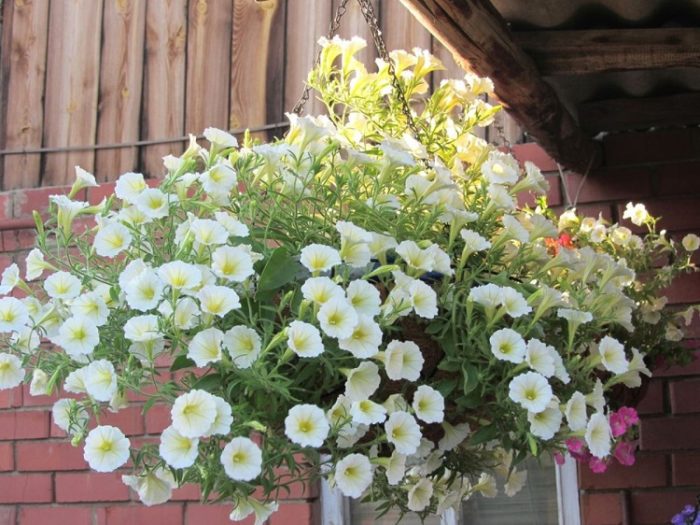
Flowers of petunias Snow Queen are large (up to 12 cm in diameter) and bright. The variety is resistant to external conditions, the length of the stems is up to 80 cm.
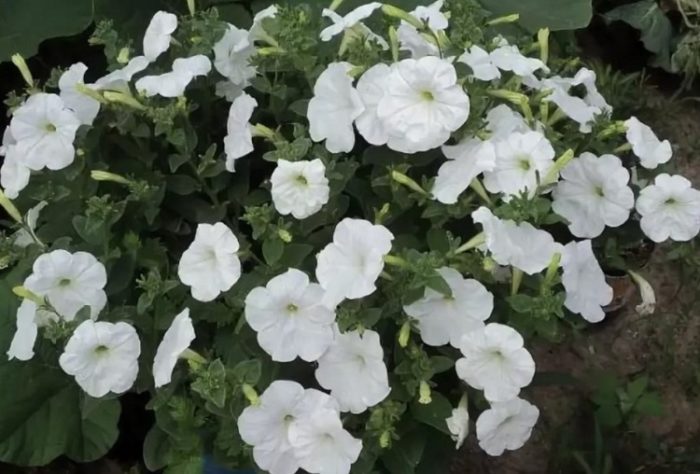
The variety White velveteen F1 differs in that in a pot the length of its stems does not exceed 90 cm, and in open ground they can stretch up to 170 cm.

Variety Velvet Rose Vine F1 early, flowers reach 6 cm in diameter. Petunia forms a very lush bush.
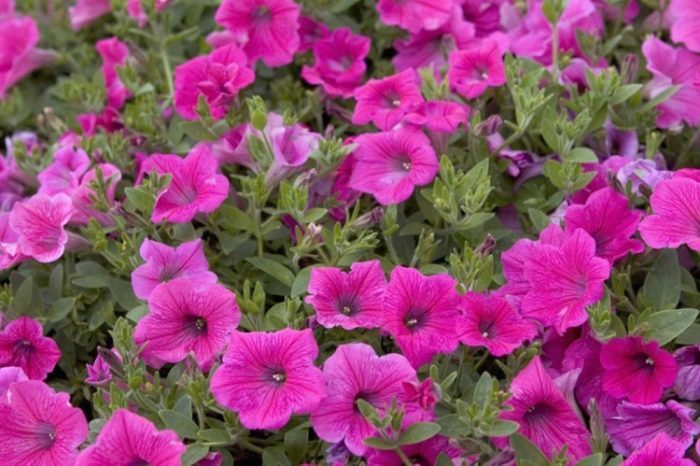
Petunias Velvet Salmon Shades have stems up to 90 cm long. The variety is resistant to fungal diseases and unpretentious to soils.
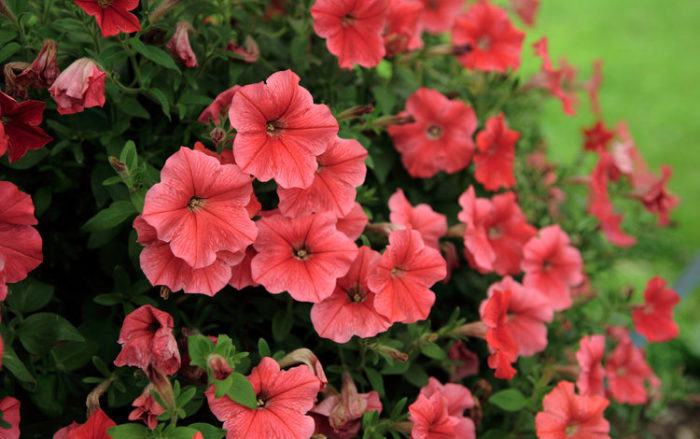
The Ocean variety grows equally well in pots and outdoors. Stems up to 1 meter long, flowers - 5-6 cm in diameter.
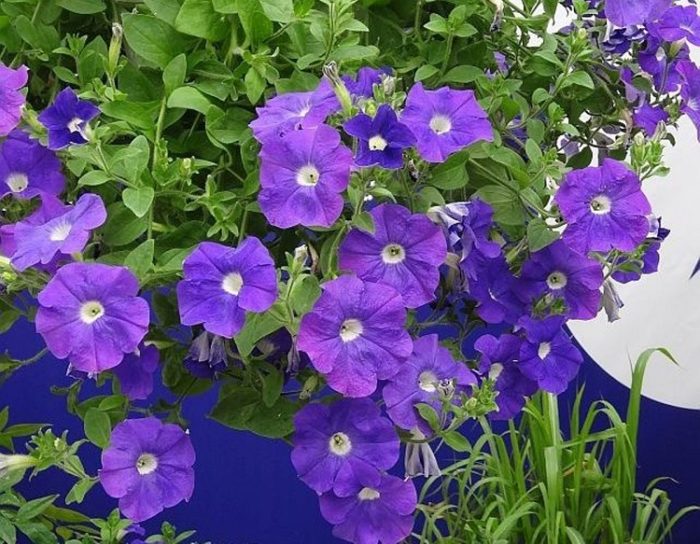
Ramblin Sugar plum is a lush and abundant variety. Shoots grow up to 60 cm, flowers can be of different shades - from pink to dark blue.
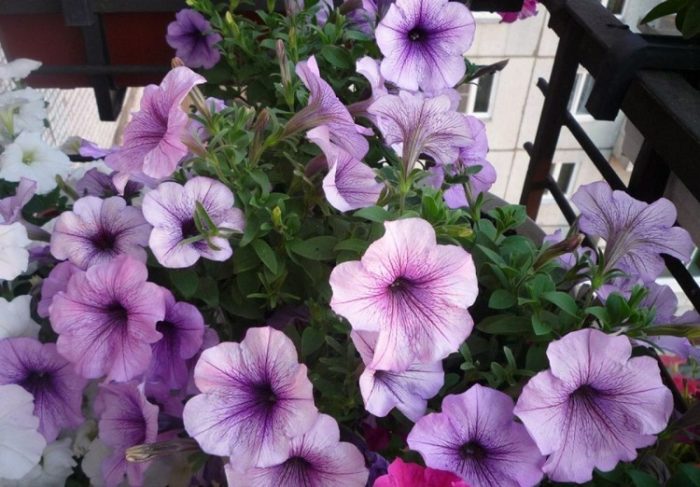
The Samba variety has relatively short stems (40-50 cm). The flowers are large, reaching 8-9 cm in diameter.

Description of varieties
Supercascade petunia was obtained in the last century. And if earlier the seeds of such varieties were rarely found in stores, today there are a huge number of them: more than a dozen.
The main advantage of the variety is the number of flowers per bush. It is incomparable with any petunia species.
Plants of blue and scarlet flowers are very popular among florists. These shades are considered the colors of hope and love. One of the best varieties for its unpretentiousness and abundant flowering is recognized as the super-cascading red and blue petunia. The variety is characterized by long shoots up to 70 cm, small rounded leaves. The flowers are simple, bell-shaped, with a fully open calyx and five fused oval petals, longitudinal grooves. The color of the petunia is velvety red, without spots or other shades. In the wider part, the diameter of the flower reaches 13 cm.
Super-cascading blue petunia is a bush about 40 cm high with hanging stems and bright cornflower blue "gramophones" 12 cm in diameter. The variety is best grown in hanging pots and other hanging structures. Early flowering of the variety, begins at the end of June.
Types and varieties of schizanthus with photos and names
The genus Schizanthus unites 12 different species. Below will be described those that are most popular with gardeners.
Schisanthus Grahamii (S. Grahamii)
The height of this annual plant is approximately 0.6 m. The flowers are pinkish-purple in color. The petals are decorated with many purple streaks and yellow spots. Breeders have bred varieties of this plant with flowers of snow-white, pink and purple colors. Its stem is strongly branching, and its homeland is the mountainous regions of Chile.
Schizanthus Feathery (S. Pinnatus)
This species is an annual. The bush reaches a height of no more than half a meter. The racemose inflorescences, which are shaped like orchid inflorescences, are made up of small purple flowers. Today, there are varieties with inflorescences of deep pink and white colors. In the middle of the flower, and at the base of the lower petal, there are many strokes and spots.
Schizanthus Vizetonsky (S. Wisetonensis)
This hybrid was created using Schizanthus Feathery and Graham. The bush reaches a height of no more than 0.6 meters. Irregularly shaped flowers reach about 20 mm in diameter. They are painted in various shades of pink, and there are also plants with white inflorescences. This type of garden is most popular with gardeners, as the plant is very showy and graceful.
Various varieties of this culture are also popular among gardeners. The best ones will be described below:
- Angel Wings. This variety belongs to the Vizetonsky schizanthus species. An annual plant can reach a height of about 0.4 meters. In the upper part of the stems, inflorescences are formed, consisting of small flowers, reaching up to 20 mm in diameter. If the plant is well looked after, then the flowering will be so lush that even the stem will not be visible due to the many beautiful flowers that can be painted pink, purple, white or carmine. The bush blooms in May, and flowering ends only in September. This variety is suitable for outdoor cultivation, as well as for growing in containers and flowerpots. It can also be grown at home.
- Monarch. This variety includes annual schizanthus. Erect shoots reach a height of about 0.4 meters. On their tops during flowering, the formation of inflorescences is observed, which include irregularly shaped flowers with a diameter of about 20 mm. They can be painted in carmine, cream, red or pink. The variety blooms magnificently and for a long time. Flowering begins in May, and ends with the first autumn frosts. You can cultivate such a plant in the garden in open soil or in containers.
- Piccollo. This annual variety belongs to the schizanthus pinnate species. The bush does not exceed 0.45 meters in height. The racemose apical inflorescences consist of many small flowers that are pink, cream or crimson in color. Such a plant can be grown not only outdoors, but also in flowerpots. The bush blooms in May, and only fades in September.
- Fiji. This exotic variety is very showy. Shoots form a pyramidal bush. The variety blooms stably, with numerous flowers tightly covering the shoots. They have a tubular shape, and reach no more than 20 mm in diameter. They can be painted pink, white or purple. A large number of spots and stripes are located on the surface of the petals. Flowers are collected in panicle inflorescences. The variety can be cultivated in a rock garden, open field or in a container.
- Hybrid F1. Hybrids belong to the Vizetonian Schizanthus species. The height of such an annual plant can reach 0.55 m. Lush bloom lasts from the first days of July to September. Panicle inflorescences consist of small flowers, reaching up to 20 mm in diameter, which have a pink, cream or crimson color, with a pattern on the petals. This hybrid mixture grows well in sunny outdoor areas, and it is also grown in beddings.
Schizanthus
Wave Series
The most unpretentious to lighting, judging by the reviews, is the petunia from the Wave series. Because of this feature, varieties are often used for vertical gardening of high areas, semi-shaded areas.
The super cascade petunia shown in the photo is unique. The bushes grow up to a meter in diameter and are covered with a thick carpet woven of small flowers 5-6 cm in size. Plant height is about 20 cm, the whips are long, about a meter.
Annual petunia is ideally adapted to the difficult conditions of our climate. This plant came to us from Brazil and took root successfully. But in warm countries, the flower grows throughout the year, showing its amazing beauty. In latitudes, where there are few warm days, the plant manages to show itself in all its glory.
La Gioconda series
This hybrid is a unique creation of breeders. This group includes plants with a huge number of flowers: there are so many of them that the green mass is completely hidden under them.
The hybrids of the series are characterized by:
- endure sharp temperature fluctuations, and the Gioconda perfectly tolerates +40 heat and short-term frosts up to -7 degrees;
- a series of plants are drought-resistant;
- has a long flowering lasting several months;
- flowers are formed at an early stage of petunia development, that is, after planting, the appearance of buds will not take long.
The varieties from this series are used as ampelous and ground cover plants. An adult bush can grow to incredible sizes, occupying an area of up to one square meter with an elevation of 20 cm above ground level.With the onset of autumn, the bushes can be moved indoors by transplanting them into pots, where petunia will delight with its beauty for a long time.
The fast-growing Gioconda series is represented by flowers of various colors. They bloom with small bells up to 5 cm in diameter. The length of the lashes is about a meter.
The series includes different shades: white, pink, red, salmon, lilac, purple, blue. Each species has its own advantageous locations. For example, the blue Mona Lisa looks amazing against the background of a white wall, and the red one complements any green corner.
Landing
As you can see from the description of many varieties of petunias, they can be planted in pots. But at the same time, it is required to strictly observe the principles of agricultural technology. If it is possible to support the seedlings with artificial lighting, the timing of planting seeds can be very early - even in February it is already possible. If this is not possible, you will have to wait until about March 15 (and sometimes a little longer). The main reference point in this case will be daylight hours.
The soil for planting seeds should be loose and contain nutrients. The lightness of the structure is also very important. The optimal composition of the planting soil is as follows:
- 1 part of selected sand;
- 2 parts of bog peat;
- 2 pieces of turf;
- 2 pieces of leafy land;
- 2 parts high quality humus.
The soil on top should be as light as possible. Simple loosening is not enough here - sifting is also needed. When about a day remains before sowing, the landing site is watered. A small amount of dry sand is also added there. Acceleration of seed development is possible by covering them with polyethylene or glass.
The container is transferred to a room with an air temperature of about +21.22 degrees Celsius. It will take about a week to wait for shoots. As soon as the growth appears, it must be carefully looked after. Humidity should be kept within the optimum range, without drying out and without condensation. As soon as the first foliage appears, the film or glass must be removed.
As soon as the seedlings in the pots have hardened, you can prepare for planting them in the ground. The best moment is the evening, when the weather is cloudy, but not damp. It is advisable to transplant seedlings together with the soil in the pots. The size of the holes for seedlings is at least 0.1x0.1 m. The distance between seedlings is determined according to their dimensions.
Varieties with large flowers should be placed at least 0.24 m. But in the case of ampelous plants, the situation is even more serious - there should be a distance of at least 0.3 m. After the end of the transplant, you should take care of the rooting as soon as possible. The best way is mulching with humus or peat. Such techniques help, among other things, improve protection against accidental frost.
Last of all, when transplanting, petunia is watered. As soon as flowering begins, you need to closely monitor the lower flowers. The best specimens are selected from them. Seeds are collected from already withered and finally ripe buds. They alone can contain flawless seeds.
Most often, planting material ripens in 75 days.
But special attention must be paid to the selection of a suitable variety. Terry ampelous petunias are unlikely to come in handy - they simply will not transmit the necessary qualities "by inheritance"
Even experienced and diligent growers may not achieve a good and stable result. Occasionally, flowers appear with a heterogeneous size, configuration, and even with a different tonality.
Large-flowered varieties can begin to bloom at 85-90 days. Small-flowered varieties have a higher growth rate - flowering begins at 70 or 75 days. It is imperative to achieve decent backlighting in the first stage of the growing season. Some gardeners are growing already flowering petunias, which are sold in a number of stores. After planting, with proper care, they will be able to bloom almost until the end of the calendar autumn.
Good seedlings can only be grown with round-the-clock illumination. At night, it must be muted, but it cannot be completely removed.
Important: you should carefully observe the thermal regime when cultivating petunias. Transplanting into new containers is done as soon as the roots look out.
It is possible to increase the stretching of seedlings by adding soil; if the variety is capricious, it must be planted from a peat tablet.
Ampel petunia should be planted in the house on the south windows
The maximum amount of sun is very important to her. If there is not enough sunlight, due to fluorescent lamps, insolation can be extended up to 17 hours per day (± 3 hours)
Sand, loam or sandy loam are suitable from soils.
What does vegetative petunia mean?
Do you have petunia - vegetative or from seeds? A couple of years ago, such a question seemed unusual, but now vegetative petunia is increasingly winning the hearts of gardeners.
Vegetative petunia propagates by cuttings. It does not form seeds. If in rare cases this happens, then the seedlings do not repeat the maternal signs.

Photo: Sweetunia Burgundy Touch and Burgundy Gem
Features of vegetative petunia
In addition to interesting varieties, vegetative petunias are favorably distinguished by stronger stems and long flowering, simplicity and unpretentiousness in care, high decorativeness.
- Long continuous flowering
In my garden in the Moscow region, ordinary petunia from seeds in hanging pots is decorative for no more than 1.5 months. Usually I sow it in 2 stages with an interval of 1 month, so that pots with petunias decorate the house throughout the season, and not just its first half.
Last season, I planted 2 vegetative petunia bushes in all hanging pots with a volume of 5 liters. Blooming "clouds" delighted me from June to October.
- Unpretentious cultivation
Vegetative petunia is simple, not demanding to care for, which explains its fantastic popularity among the seed petunia we are used to.
- Since no seeds are formed, there is no need to constantly remove faded flowers. The plant cleans itself, which significantly saves time.
- More stocky, does not stretch and puts up with a small volume of planting capacity, which gives the gardener real pleasure.
- Plants differ in the minimum requirements for feeding, in their complete absence and regular watering, they will bloom well.
- If you want a luxurious flowering, feed it with a complex fertilizer for flowers every 1.5 weeks.
- High decorativeness
- Differs in a dense texture of petals, so it retains an attractive appearance even after rains.
- The length of the shoots is no more than 40 cm, therefore, compositions with it are always compact, spherical in shape.
- Does not waste energy on the formation of numerous seeds, prolonging the flowering period.
Pros of growing
- Does not form seeds, which means it does not need regular pruning.
- It is not susceptible to powdery mildew, which means that it does not need preventive treatments.
- Does not stretch and does not need pinching. After the cuttings are rooted, the plant branches out evenly and, without the help of a gardener, forms a charming blooming ball.
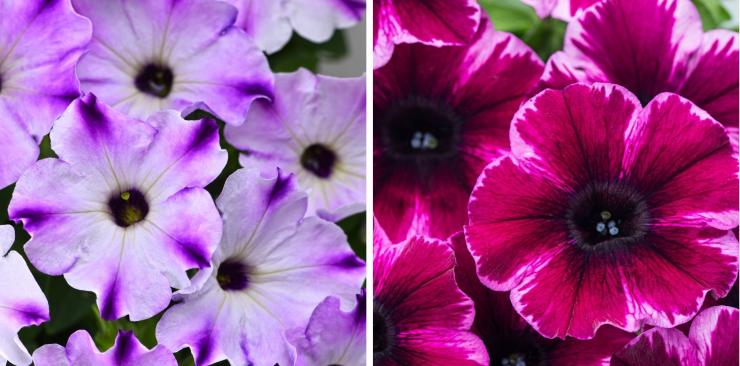
Photo: Crazytunia Berry Frappe and Ultra Violet


